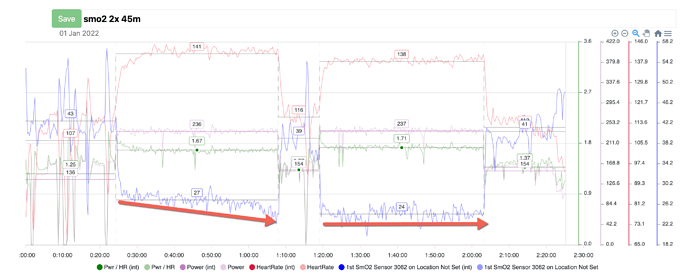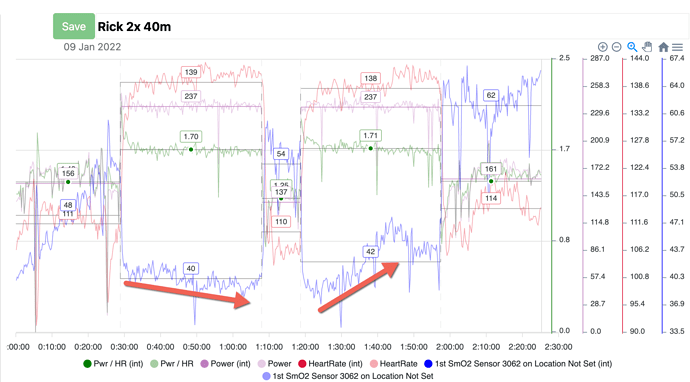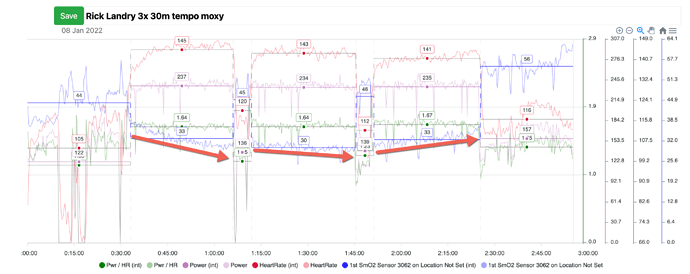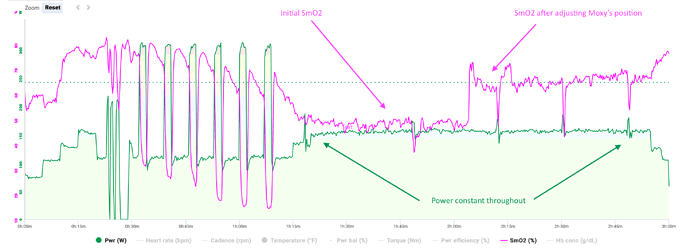Yeah - I mean I don’t know him but he’s the son of your mentor, correct?
This is good. I’m going to try this today. I hate static rest but it def seems to make a difference. I wonder if you’d see the same superiority if you reversed the order of the tests?
Why don’t you try it both ways and let me know 
I have done this every which way and then some.
What is good about having the device yourself is being able to see how you are affected by different ideas.
Steve, I’d be over the moon if you could somehow get Andri or Juerg (or Skiba even though he won’t share much!) on your podcast. I’ve been a Moxy fan boy for some time.
Interesting I showed Phil how to find LT1 with a moxy  but he is a wicked smart guy.
but he is a wicked smart guy.
Will work on Andri first because of my history with Juerg but Philip would be great as he uses the moxy different.
Here are few different interpretations.
We have looked at some different types of testing.
The most important thing to note is do we have increasing smo2 during steady work ?
or do we have stable smo2 during steady work ?
or do we have declining smo2 during steady work ?
These are usually very easy ways to find Aerobic Threshold, Tempo, Threshold during a step test.
Below are 3 examples of a similar workout of the same athlete during a ten day period starting a long tempo interval block.
This was the first workout of the session, based on heart rate, power and power to heart rate I would say this was just fine.
If we look at the smo2, it would have been better to do the first interval a little lower, to have a more stable smo2, and then the second interval would have likely been a higher wattage, but both with the same perceived exertion.
+++
Below is the second session
Similar but shows the same picture…
+++
The third session
Another similar picture.
So the moral here is that I feel if you have a goal wattage, the first interval should always be a little easier than that goal.
The second interval should be likely on that goal.
The third if there is one could likely be above that goal. Creating a building wattage session.
Now, if you were to use the moxy live, which the athlete will do next week, they will make sure NOT to let the smo2 decline on the second interval, getting as close to the wattage goal as possible.
Then second interval goal will be to do the same, but wattage will likely be higher.
For the third same idea, and again the wattage will likely be higher.
So all those times you wondered why the more intervals you do the better they felt…this is why.
So using a moxy can help through defining training zones in testing, but better yet it really helps make sure you do the right load within a range to help make every workout at the right level.
I have definitely noticed this pattern.
In the examples above, and in my experience as well, in the 2nd interval you can see a reduced HR.
What do we attribute this to?
A) Improved/deeper breathing as the workout progresses?
B) Vasoconstriction of non-working muscles/viscera?
C) Does timing play a role? The 2nd intervals above all started after an hour of work. Is there a warm-up effect? (muscle temp, aerobic enzymatic processes, etc…) If we warmed up for an hour prior to the intervals would that change anything?
All great questions.
The only ones I have confidence or proof to answer would be A the breathing, I have seen this often if not always when long intervals have been done on a metabolic cart.
B - I have no proof
C - Yes we know the warm-up has an effect on the session for sure. I would say that this athlete needs a longer, easier, more gradual warm-up (which he is going to try this week).
More importantly this part of this post was about how can we best use the moxy to pace a workout and get the most out of it.
So let’s say 225 - 235 - 245 intervals might get the best smo2 response and give us an average of 235 similar to the session above with all being the same.
Would the athlete feel better?
Would they recover better for the next day?
Would they learn more about different aspects of their body feel, muscles, breathing, heart rate, perception which might help them pacing in an event?
Why don’t you come back to us with some examples of the the questions I can’t answer, they are good ones just not where I have spent time learning.
This is super interesting. It appears the relative degree of desaturation during a ramp test and/or other hard efforts can be used as a proxy for fiber type distribution. Those with a high percentage of Type 1 fibers tend to be unable to desaturate significantly whereas those with high levels of Type II tend to be able to bring SmO2 down a much greater degree.
Personally, I rarely see SmO2 levels above 60% and can bring levels down into the teens just doing sweet spot at times, so this is informative.
And an interpretation here:
Nice finds 
Have you tried using your moxy, on the quad, during bodyweight squats 
If you haven’t, try do decent range of motion squats, and move about 2-3 seconds per repetition - see how low you can get the moxy to go while squatting. Then stand still and rest until it goes to max, do this for 4-5m and let me see the fit file.
Hi @steveneal and thanks for the reply! You are saying 4-5m continuous? Or do I do several sets till SmO2 is low, then recover, then try again?
Just did a few for an example.
Really just trying to see if you can get smo2 lower off the bike.
You should be able to go pretty deep or to a plateau at the bottom in around 30-40 reps I would say.
Okay - will try in a bit. Did you use a bike computer to recored? I have VO2 Master but not sure it exports a fit file. Need to run some errands first. Thank you!
used garmin to record.
@steveneal I sent the file. Compared to your nice curves I have very little movement. Sorta feel broken. I hope you can shed some light on the data.
A reminder of how important it is to consistently and accurately position the Moxy. Initial position - 48% saturation. After repositioning 65%. Probably 5cm difference max.
Yup…remember the tattoo all my athletes have 
Very important.
@fazel1010 on another note. The smo2 at the first recovery was around 80% — next time you try these intervals - use the same wattage ON and same duration - but for recovery don’t start until you get to the same smo2 as the first.
Note your declining smo2 at the beginning of each interval. I would lengthen the recoveries.
I can get differences like that @ 5 mm max.
I do often draw an outline on my thigh with a sharpie to aid consistent positioning.
A sharp tan line makes for a good reference point. @steveneal is this the tattoo you’re referring to?
@fazel1010 could the sensor have been slipping during those intervals? Might have exaggerated the drift in deoxy nadirs and reoxy peaks?
@SpareCycles yeah - I think so. I try to avoid taping but I might have to go back to it to ensure consistency.





